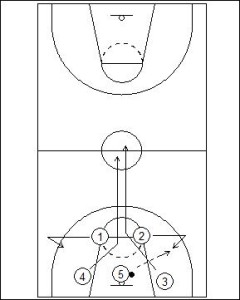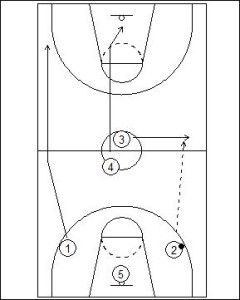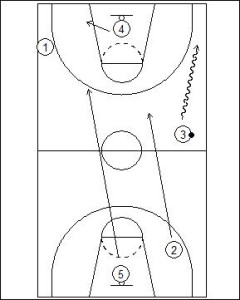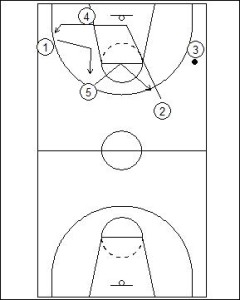Primary Transition: Small Forward Link
The Primary Transition Small Forward Link Play looks to exploit the strength of the player filling the Three (Small Forward) in the team’s offense. This Primary Transition looks to provide space for the Three (3) player in the full court allowing for a strong player to be isolated more significantly from help defence. This is very effective if this player is very powerful on the dribble, as this will mean a numbers advantage in most situations when attacking the basket from the Primary Transition providing the Small Forward (Three) can beat their player off the dribble.
Additionally, by playing a pivotal player at this position there is also the opportunity to utilise this stop as a pressure release option against full court or extended pressure defence situations. This will be of use to teams who struggle with trapping pressure because of a weakness in the backcourt.

To help with the explanation of the primary transition movements, the set-up for the offensive players is out of a 2-3 Zone Defence.
One (1) and Two (2) fill outlet roles. Both players lead for the ball by first breaking the three-point line and then continuing to lead back for the ball until either one has received the outlet pass.
The best position for the guards (One and Two) to receive a pass is when they are in the outlet pocket. Which is on the foul line extended on the three-point line.
Three (3) once possession is confirmed is in a dead sprint to reach the halfway line while the two guards are creating a lead.
The two forwards who did not get the rebound (Three and Four) start a sprint to the halfway line trying to go through the centre circle.
The rebounder (Five) looks for the outlet and trails the ball up the floor. This player should remain behind the line of the ball and be a pressure release passing option if needed.
Three (3) is the primary target to be the second receiver in the primary transition. However if this player secures the rebound, then it will be the first player out of Four (4) or Five (5) who reaches halfway will move to this position.

The first forward to halfway (3) cuts to the strong side sideline looking for the pass (as the second receiver) from the outlet (2).
The second forward (Four) over halfway sprints to the front of the basket.
The weak side guard (One) sprints down the sideline creating width on the court.
The outlet (Two) once they have received the ball, will look to pass first, then dribble if no option is present.
The order of passing options will be:
- Three (3) down the strong side sideline
- Four (4) on the front of the rim
- One (1) from skip pass across court
- Five (5) with a pressure release pass

The sideline receiver (3) upon catching the ball squares up to the basket looking for the post target (Four). If the post target is not an option, attacking dribbles are used to bring the ball below the broken circle extended on the 3-point line or attack the basket aggressively.
This is the time when an offensively dominant Small Forward (Three) can break down their defensive match-up and create an advantage in offense.
If the post target (Four) has not received the ball by the time it has reached the broken circle extend then they move to the weak side of the key in line with the backboard.
Two (2) makes a read and if the post is moving out of the key, then two will speed up.

Two (2) cuts hard off the movement starting from the outlet to the basket at full pace.
Five (5) replaces off shallow cut, and creating lead for the ball
One (1) replaces off shallow cut, and creating lead for the ball
This movement should help create initial player movement out of the primary transition and lead into a team’s half-court offense.







